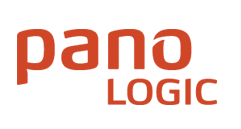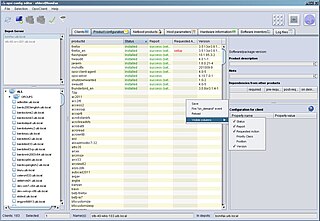
Esri is an American multinational geographic information system (GIS) software company. It is best known for its ArcGIS products. With a 43% market share, Esri is the world's leading supplier of GIS software, web GIS and geodatabase management applications. The company is headquartered in Redlands, California.
An application program is a computer program designed to carry out a specific task other than one relating to the operation of the computer itself, typically to be used by end-users. Word processors, media players, and accounting software are examples. The collective noun "application software" refers to all applications collectively. The other principal classifications of software are system software, relating to the operation of the computer, and utility software ("utilities").
MKS Toolkit is a software package produced and maintained by PTC that provides a Unix-like environment for scripting, connectivity and porting Unix and Linux software to Microsoft Windows. It was originally created for MS-DOS, and OS/2 versions were released up to version 4.4. Several editions of each version, such as MKS Toolkit for developers, power users, enterprise developers and interoperability are available, with the enterprise developer edition being the most complete.
Open iT, Inc. is an independent software vendor that specializes in metering, analyzing, and optimizing usage of critical IT assets. It was founded in 1999 by Eistein Fosli, who obtained his Master of Science in Information Technology from the University of Oslo.
Software asset management (SAM) is a business practice that involves managing and optimizing the purchase, deployment, maintenance, utilization, and disposal of software applications within an organization. According to ITIL, SAM is defined as “…all of the infrastructure and processes necessary for the effective management, control, and protection of the software assets…throughout all stages of their lifecycle.” Fundamentally intended to be part of an organization's information technology business strategy, the goals of SAM are to reduce information technology (IT) costs and limit business and legal risk related to the ownership and use of software, while maximizing IT responsiveness and end-user productivity. SAM is particularly important for large corporations regarding redistribution of licenses and managing legal risks associated with software ownership and expiration. SAM technologies track license expiration, thus allowing the company to function ethically and within software compliance regulations. This can be important for both eliminating legal costs associated with license agreement violations and as part of a company's reputation management strategy. Both are important forms of risk management and are critical for large corporations' long-term business strategies.
International standards in the ISO/IEC 19770 family of standards for IT asset management address both the processes and technology for managing software assets and related IT assets. Broadly speaking, the standard family belongs to the set of Software Asset Management standards and is integrated with other Management System Standards.

Pano Logic was a manufacturer of devices which present virtual desktops to the end user with no local processing power. They describe this concept as "zero client". This is perceived as offering benefits in end-user support and in power provision to desks. OEM versions have been included in displays from some vendors, allowing a single unit to be deployed. The company failed in October 2012. In March 2013, Propalms announced they had acquired the rights to support Panologic customers, and will "help transition the customer base to a new platform".

Phoronix Test Suite (PTS) is a free and open-source benchmark software for Linux and other operating systems which is developed by Michael Larabel and Matthew Tippett. The Phoronix Test Suite has been endorsed by sites such as Linux.com, LinuxPlanet, and Softpedia.
ThinkVantage Technologies is a set of system support utilities to reduce total cost of ownership of Lenovo brand desktop and laptop computers.

Opsi is a software distribution and management system for Microsoft Windows clients, based on Linux servers. Opsi is developed and maintained by uib GmbH from Mainz, Germany. The main parts of Opsi are open-source licensed under the GNU Affero General Public License.
IT cost transparency is a category of information technology management software and systems that enables enterprise IT organizations to model and track the total cost to deliver and maintain the IT Services they provide to the business. It is increasingly a task of management accounting. IT cost transparency solutions can integrate financial information such as labor costs, software licensing costs, hardware acquisition and depreciation, data center facilities charges from general ledger systems and combine this with operational data from ticketing, monitoring, asset management and project portfolio management systems to provide a single, integrated view of IT costs by service, department, GL line item and project. In addition to tracking cost elements, IT cost transparency may track utilization, usage and operational performance metrics in order to provide a measure of value or return on investment (ROI). Costs, budgets, performance metrics and changes to data points are tracked over time to identify trends and the impact of changes to underlying cost drivers in order to help managers address the key drivers in escalating IT costs and improve planning.
Ember was an American company based in Boston, Massachusetts, USA, which is now owned by Silicon Labs. Ember had a radio development centre in Cambridge, England, and distributors worldwide. It developed Zigbee wireless networking technology that enabled companies involved in energy technologies to help make buildings and homes smarter, consume less energy, and operate more efficiently. The low-power wireless technology can be embedded into a wide variety of devices to be part of a self-organizing mesh network. All Ember products conform to IEEE 802.15.4-2003 standards.

RM Education is the principal division of RM plc, a British company that specialises in providing information technology products and services to educational organisations and establishments. Its key market is UK education including schools, colleges, universities, government education departments and educational agencies.

The Attachmate Group, Inc. was a privately held software holding company based in Houston, Texas in the United States. The major companies held by the group were Attachmate, NetIQ, Novell, and SUSE.

Teradici Corporation was a privately held software company founded in 2004, which was acquired by HP Inc. in October 2021. Teradici initially developed a protocol (PCoIP) for compressing and decompressing images and sound when remotely accessing blade servers, and implemented it in hardware. This technology was later expanded to thin clients/zero clients for general Virtual Desktop Infrastructure. Teradici's protocol or hardware is used by HP, Dell-Wyse, Amulet Hotkey, Samsung, Amazon Web Services, Fujitsu, and VMware.
Perforce, legally Perforce Software, Inc., is an American developer of software used for developing and running applications, including version control software, web-based repository management, developer collaboration, application lifecycle management, web application servers, debugging tools and Agile planning software.
Array Networks is an American networking hardware company. It sells network traffic encryption tools.
VDIworks is an American software company founded in 2008 that provides services like desktop virtualization, desktop as a service (DaaS), networking, PCoIP and cloud computing.

Lansweeper is an IT asset management solution that gathers hardware and software information of computers and other devices on a computer network for management, compliance and audit purposes.
Data center management is the collection of tasks performed by those responsible for managing ongoing operation of a data center This includes Business service management and planning for the future.







